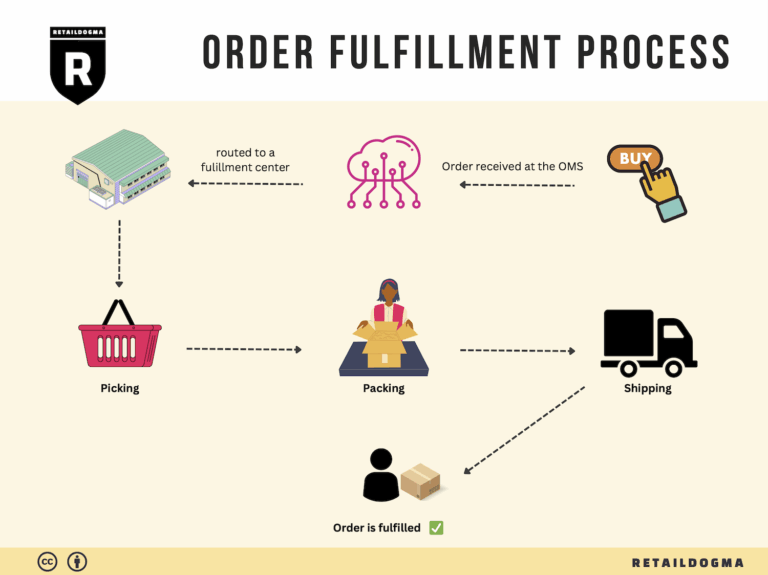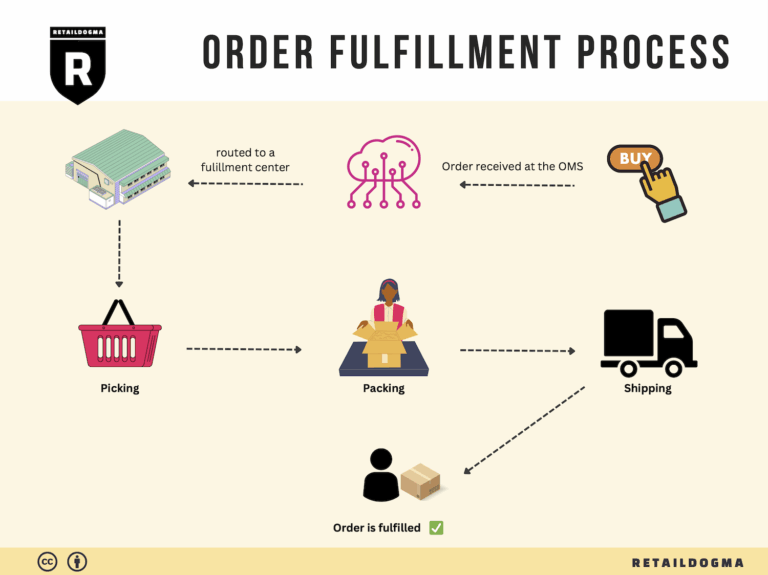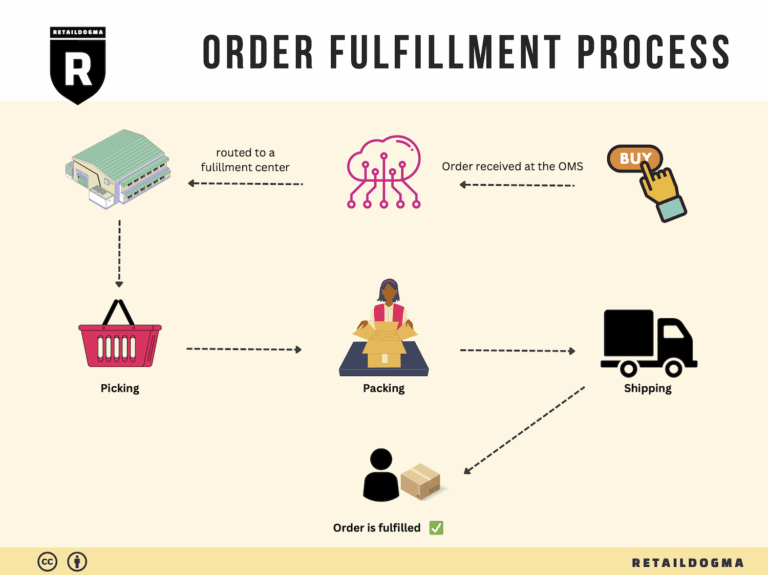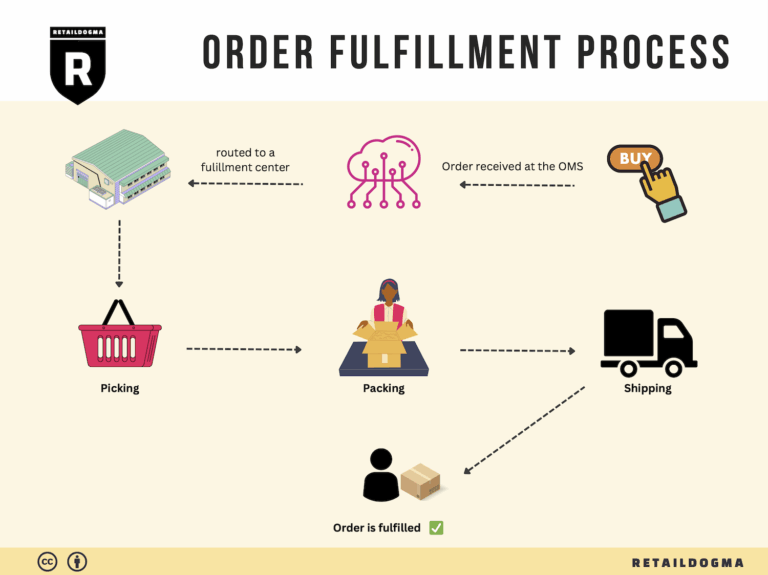Ecommerce Fulfillment Services: The Ultimate Guide (2025)
What is E-commerce Fulfillment? An Introduction for Growing Businesses
Understanding E-commerce Fulfillment
As an e-commerce business owner, you may find yourself overwhelmed with the intricacies of packing and shipping orders. The excitement of sales can quickly turn into a logistical nightmare, especially as your business scales. Managing inventory, ensuring timely deliveries, and handling returns can consume valuable time and resources, detracting from your focus on growth and customer satisfaction.
In simple terms, e-commerce fulfillment is the process of getting a product from your warehouse or supplier to your customer’s doorstep. It encompasses everything from receiving inventory and processing orders to picking, packing, shipping, and handling returns. Understanding this process is crucial for any business looking to streamline operations and enhance customer experience.
This guide will delve into the various models of e-commerce fulfillment available to growing businesses. We will explore the most popular options, including Third-Party Logistics (3PL) and Fulfillment by Amazon (FBA). Each model has its unique advantages and challenges, and the right choice will depend on your specific business needs, product types, and target markets.
Additionally, we will outline the core services associated with fulfillment, such as inventory management, order processing, shipping options, and customer support. Knowing what services to expect from a fulfillment partner can help you set the right expectations and avoid common pitfalls.
Choosing the right fulfillment partner is a critical decision that can significantly impact your business operations. This guide will provide insights into what to look for in a partner, including their technology capabilities, scalability, and customer service track record.
Pricing can also be a complex aspect of e-commerce fulfillment. We will break down the various costs involved, helping you understand how to budget for fulfillment services while ensuring that you maintain healthy profit margins.
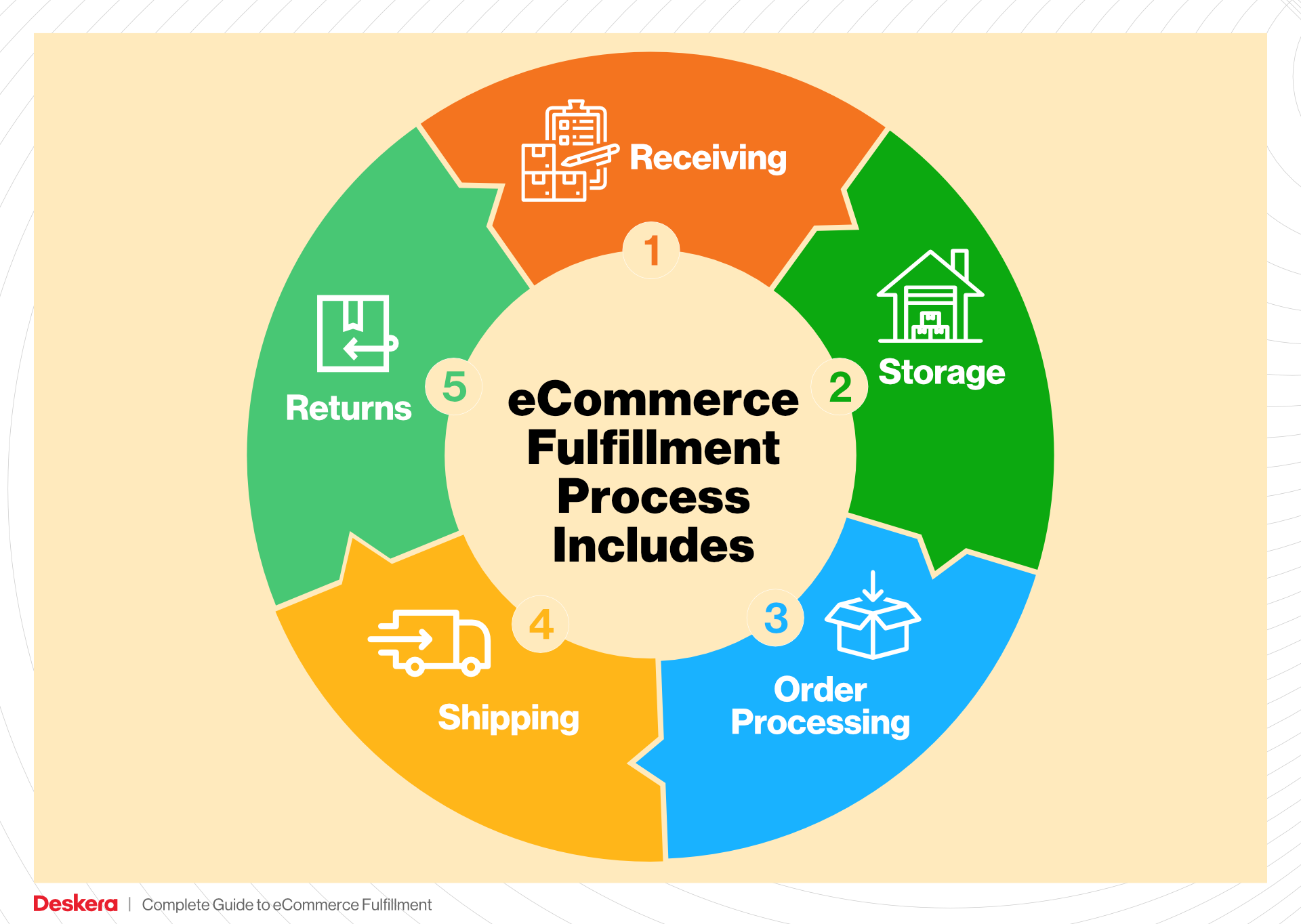
Ultimately, this guide aims to empower you to make informed decisions about your logistics strategy. By understanding the fundamentals of e-commerce fulfillment and the available options, you can choose the best path for your business, allowing you to focus on what you do best: serving your customers and growing your sales.
What You’ll Learn In This Guide
- What is E-commerce Fulfillment? An Introduction for Growing Businesses
- The Order Fulfillment Process: From ‘Buy’ Button to Customer’s Door
- Comparing Fulfillment Models: In-House vs. 3PL vs. Dropshipping
- A Deep Dive into Amazon FBA: Pros, Cons, and Who It’s For
- Core Services Offered by Fulfillment Centers
- How to Choose a Fulfillment Partner: A 6-Point Checklist
- Understanding Fulfillment Pricing: A Breakdown of Common Fees
- Frequently Asked Questions (FAQs) about Fulfillment
- Conclusion: Is Outsourcing Fulfillment the Right Move for Your Business?
- Important Disclaimer
The Order Fulfillment Process: From ‘Buy’ Button to Customer’s Door
1. Receiving Inventory
The order fulfillment process begins with receiving inventory at the fulfillment center. This step involves checking incoming shipments against purchase orders to ensure that the correct items and quantities have been delivered. Each product is assigned a unique Stock Keeping Unit (SKU), which simplifies tracking and inventory management. Upon receiving, items are inspected for quality and any damages, and discrepancies are recorded for resolution.
This step is crucial because it establishes the accuracy of inventory levels and ensures that only quality products are stored. If the receiving process is not executed properly, it can lead to stockouts, overstock situations, or customer dissatisfaction due to missing or defective items. Effective receiving practices can enhance operational efficiency and minimize costs associated with returns and lost sales.
2. Warehouse Storage
Once inventory is received and verified, the next step is warehouse storage. In a fulfillment center like Amazon’s, which spans over 1 million square feet, efficient storage is vital. Products are categorized and stored based on their SKUs in designated locations, often utilizing automated systems to optimize space. This includes implementing a well-planned inventory management system that tracks where items are stored and their availability.
Proper storage is essential for several reasons. First, it ensures that products are easily accessible for the picking process, which reduces the time taken to fulfill orders. Second, it helps in maintaining an organized warehouse, which is critical for operational efficiency. Using techniques such as first-in, first-out (FIFO) or last-in, first-out (LIFO) can further enhance inventory turnover and reduce waste.
3. Order Picking
Order picking is the process of selecting items from the warehouse to fulfill customer orders. This step is typically guided by pick lists, which detail the items, quantities, and locations within the warehouse. In advanced fulfillment centers, automation and robotics play a significant role in optimizing this process, allowing for faster and more accurate picking.
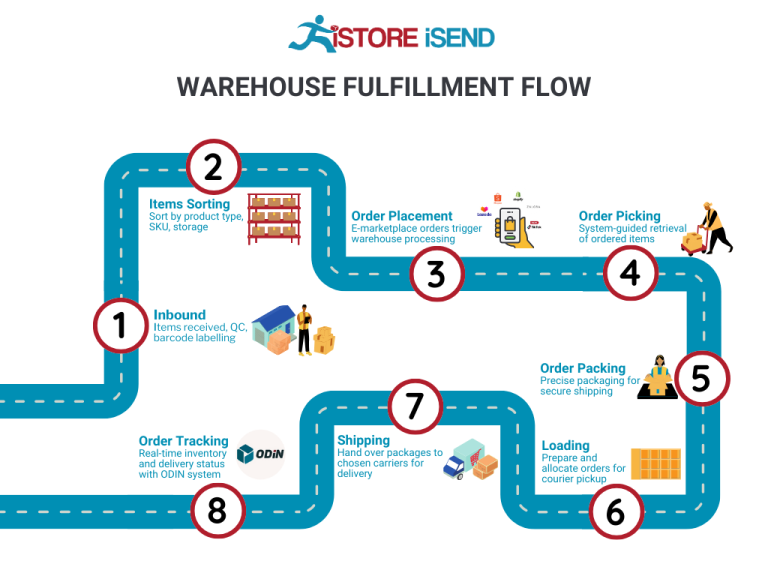
The importance of order picking cannot be overstated. It directly impacts the speed and accuracy of order fulfillment. Delays or errors in picking can lead to customer dissatisfaction, increased return rates, and additional shipping costs. To mitigate these risks, businesses can implement technologies like pick-to-light systems or mobile picking devices that enhance efficiency and accuracy.
4. Order Packing
After items are picked, they move to the packing stage. In this step, products are carefully packaged for shipment. This involves selecting the appropriate packing materials, ensuring items are securely wrapped, and generating shipping labels. Companies often use packing slips that include order details and return instructions to enhance the customer experience.
Order packing is a critical step for ensuring that products arrive safely at the customer’s doorstep. Poor packing can lead to damaged goods, resulting in returns and customer dissatisfaction. Additionally, efficient packing processes can help reduce shipping costs by minimizing dimensional weight and ensuring optimal use of space within shipping containers. Using automated packing systems can streamline this process and increase throughput.
5. Shipping & Delivery
The final step in the order fulfillment process is shipping and delivery. Once packages are packed, they are handed over to shipping carriers for delivery to customers. Fulfillment centers like Amazon’s in Omaha utilize a network of transportation partners to ensure timely delivery. Tracking systems are also put in place to provide customers with real-time updates on their order status.
This step is vital as it represents the last touchpoint between the business and the customer. Timely and reliable delivery can significantly enhance customer satisfaction and loyalty. Businesses should prioritize establishing relationships with efficient carriers and consider offering multiple shipping options to cater to different customer needs. Additionally, investing in a robust logistics management system can help streamline shipping operations and improve overall efficiency.
By understanding and optimizing each step of the order fulfillment process, e-commerce businesses can significantly enhance their operational efficiency, reduce costs, and improve customer satisfaction.
Comparing Fulfillment Models: In-House vs. 3PL vs. Dropshipping
Comparison of Fulfillment Models
| Model | Who Handles Inventory | Best For (Business Stage) | Key Advantage | Key Disadvantage |
|---|---|---|---|---|
| In-House Fulfillment | Business owns and manages inventory | Established businesses with stable demand | Full control over inventory and operations | High overhead costs and resource requirements |
| Third-Party Logistics (3PL) | Third-party provider manages inventory | Growing businesses looking to scale | Cost-effective and scalable logistics solutions | Less control over operations and potential for communication issues |
| Dropshipping | Supplier/manufacturer ships directly to customer | Startups and small businesses with limited capital | Low upfront investment and minimal risk | Lower profit margins and reliance on suppliers for product quality and availability |
In-House Fulfillment
In-house fulfillment involves a business managing its own inventory and logistics operations. This model is often adopted by established companies that have a steady demand and can justify the investment in warehousing and staff. The primary advantage of in-house fulfillment is the level of control it provides. Businesses can oversee every aspect of the order fulfillment process, from inventory management to shipping. This autonomy allows for tailored customer service, the ability to implement custom packaging, and immediate adjustments based on operational feedback. However, this model also comes with significant overhead costs, including warehousing, staffing, and technology investments. As a business scales, these costs can become burdensome, making in-house fulfillment less feasible for companies that experience fluctuating demand or are looking to expand rapidly.
Third-Party Logistics (3PL)
Third-party logistics (3PL) is a fulfillment model where a business outsources its logistics and inventory management to a specialized provider. This option is ideal for growing businesses that seek to scale their operations without the complexities of managing their own warehouses and logistics. 3PL providers offer a range of services, including warehousing, inventory management, order fulfillment, and shipping. The key advantage of utilizing a 3PL is the cost-effectiveness and scalability it offers. Businesses can leverage the infrastructure and expertise of the 3PL, allowing them to focus on core operations such as marketing and sales. However, the downside is that businesses may experience reduced control over their fulfillment processes, which can lead to communication issues and potential delays if the 3PL does not align with the company’s standards for customer service and efficiency.
Dropshipping
Dropshipping is a fulfillment model where the retailer does not keep products in stock. Instead, when a customer places an order, the retailer purchases the item from a third-party supplier, who then ships it directly to the customer. This model is particularly attractive for startups and small businesses with limited capital, as it requires little upfront investment and eliminates the risk of unsold inventory. The primary advantage of dropshipping is the minimal financial risk and operational burden it places on the retailer. However, it is important to note that dropshipping typically comes with lower profit margins due to the added costs of third-party fulfillment. Additionally, retailers rely heavily on suppliers for product quality, availability, and shipping timelines, which can lead to issues if the supplier fails to meet expectations. As a result, maintaining a strong relationship with reliable suppliers is crucial for success in this model.
Conclusion
Choosing the right fulfillment model is critical for e-commerce businesses, especially those looking to scale. Each option—In-House Fulfillment, 3PL, and Dropshipping—has its unique advantages and challenges. In-house fulfillment offers control but requires significant investment, while 3PL provides scalability at the cost of some operational control. Dropshipping minimizes risk but often leads to lower margins and reliance on third-party suppliers. Business owners must assess their specific needs, market conditions, and growth ambitions to select the fulfillment strategy that best aligns with their long-term objectives.
A Deep Dive into Amazon FBA: Pros, Cons, and Who It’s For
Understanding Fulfillment by Amazon (FBA)
Fulfillment by Amazon (FBA) is a service provided by Amazon that allows e-commerce sellers to store their products in Amazon’s fulfillment centers. When a customer orders a product, Amazon takes care of storage, packaging, and shipping, as well as customer service and returns. This enables sellers to leverage Amazon’s vast logistics network and customer base to grow their businesses.
When a seller enrolls in FBA, they send their inventory to one or more of Amazon’s fulfillment centers. Amazon then manages the storage and fulfillment process. Products listed through FBA are eligible for Amazon Prime and are often featured with the “Fulfilled by Amazon” logo, which can boost visibility and trust among potential buyers.
How FBA Works
-
Setup and Registration: Sellers create an Amazon seller account and opt for FBA. They can list their products and decide which items to fulfill through Amazon’s network.
-
Shipping Inventory: Sellers ship their products to Amazon’s fulfillment centers. Amazon provides guidance on how to package and label items for efficient processing.
-
Storage: Once received, Amazon stores the inventory in their warehouses. Sellers can monitor their inventory levels through the Amazon Seller Central dashboard.
-
Order Fulfillment: When a customer places an order, Amazon picks, packs, and ships the product. They also handle customer inquiries and returns.
-
Payment: After the order is completed, Amazon processes the payment and transfers the funds to the seller, minus applicable fees.
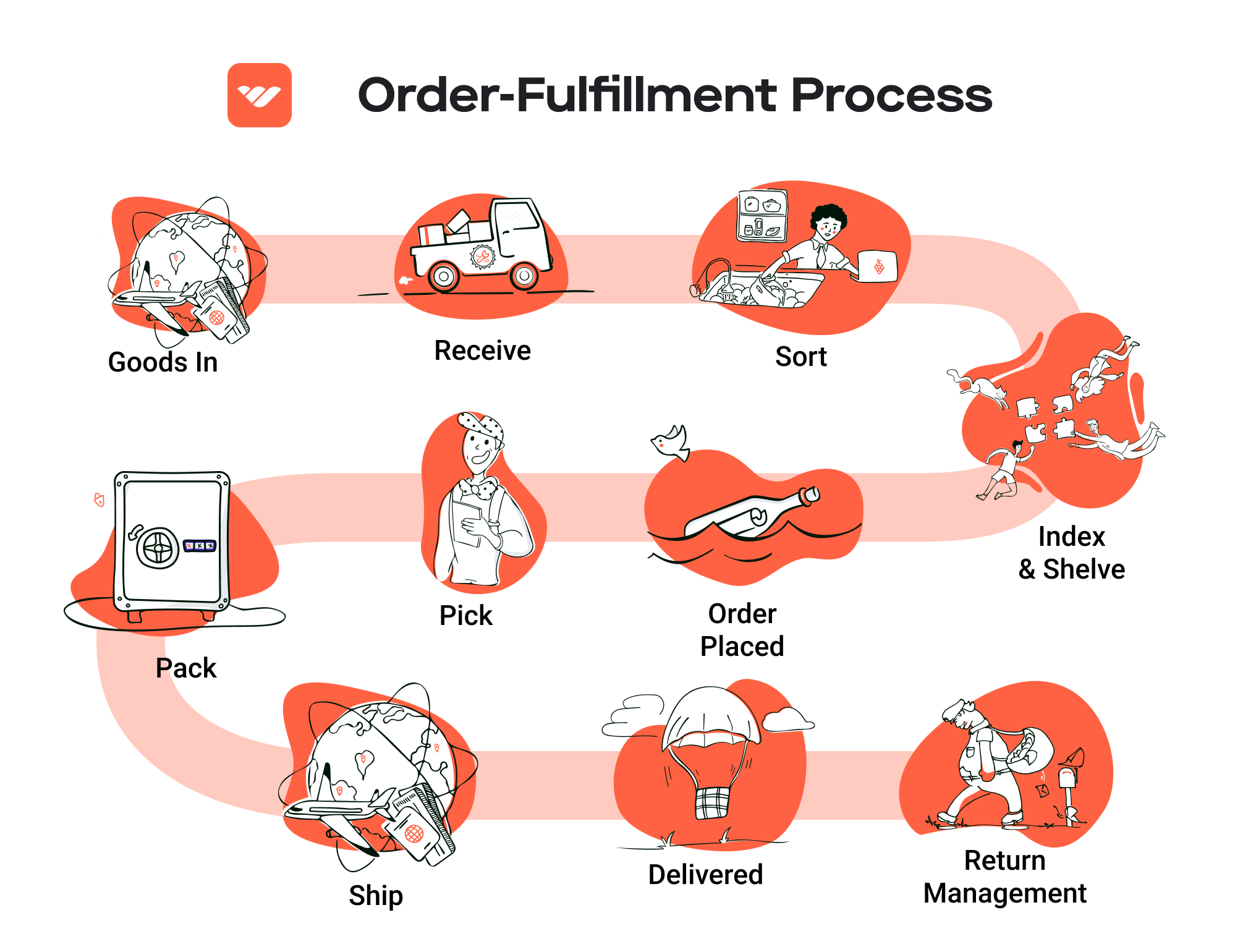
Pros of FBA
-
Prime Eligibility: One of the most significant advantages of using FBA is that products become eligible for Amazon Prime, which attracts millions of loyal Prime members who prefer fast, free shipping.
-
Customer Trust: Products fulfilled by Amazon often carry a higher level of trust among consumers. Customers know they can rely on Amazon for quality service, including easy returns and customer support.
-
Multi-Channel Fulfillment: FBA allows sellers to use Amazon’s infrastructure to fulfill orders from other sales channels, such as their own websites or other e-commerce platforms. This streamlines logistics and enhances efficiency.
-
Scalability: FBA provides a scalable solution for growing businesses. Sellers can increase their inventory without worrying about storage space or logistics, as Amazon handles these aspects.
-
Time Savings: By outsourcing fulfillment to Amazon, sellers can focus on other critical areas of their business, such as product development and marketing, rather than logistics.
Cons of FBA
-
High Fees: While FBA offers many benefits, it comes at a cost. Sellers are charged various fees, including storage fees for inventory stored in Amazon’s warehouses and fulfillment fees based on the size and weight of the products. These fees can significantly eat into profit margins.
-
Strict Inventory Rules: Amazon has strict inventory management policies. Sellers must adhere to these rules regarding labeling, packaging, and inventory limits. Non-compliance can result in additional fees or, in severe cases, account suspension.
-
Commingling Risks: Amazon may commingle inventory from multiple sellers, which means that products from different sellers are stored together. This can lead to issues if a seller receives negative reviews due to a defective item that was not theirs, as it may be challenging to prove the origin of the products.
-
Limited Control: Sellers relinquish a degree of control over their inventory once they enroll in FBA. Amazon dictates many aspects of the fulfillment process, including shipping methods and packaging standards.
-
Variable Performance: While Amazon is known for its efficient logistics, issues can arise, such as delays in shipping or inventory management errors. These can negatively impact a seller’s reputation and sales.
Who is FBA Best For?
Fulfillment by Amazon is an excellent option for various types of e-commerce businesses, particularly:
-
Small to Medium-Sized Businesses: Companies that lack the resources to manage their own warehousing and fulfillment can benefit significantly from FBA, as it allows them to scale without the associated logistics headaches.
-
New Sellers: Entrepreneurs who are just starting can leverage FBA to quickly access a vast customer base and the infrastructure needed for order fulfillment, enabling them to focus on marketing and sales rather than logistics.
-
Brands Looking for Growth: Established brands seeking to expand their market presence can use FBA to enhance their reach, especially in competitive niches where Prime eligibility can make a substantial difference in visibility and sales.
-
Sellers with Seasonal Products: Businesses that experience seasonal spikes in demand can benefit from FBA’s ability to handle fluctuations in inventory without the need for long-term storage solutions.
In conclusion, Fulfillment by Amazon offers numerous advantages that can help e-commerce businesses grow and thrive in a competitive marketplace. However, it is essential for sellers to weigh the pros and cons carefully, considering their unique circumstances and business goals before committing to the FBA model.
Core Services Offered by Fulfillment Centers
Inventory Management & Warehousing
Inventory management and warehousing are fundamental services provided by fulfillment centers, ensuring that e-commerce businesses can efficiently store, track, and manage their stock levels. This process involves receiving, storing, and organizing products within a facility to maximize space and streamline retrieval.
For e-commerce businesses, effective inventory management leads to several key benefits. First, it minimizes the risk of stockouts or overstock situations, allowing businesses to meet customer demand without tying up unnecessary capital in unsold inventory. Advanced inventory systems often utilize real-time tracking technology, providing insights into stock levels, sales trends, and reorder points. This data-driven approach enables businesses to make informed decisions about purchasing and stocking, ultimately enhancing operational efficiency and customer satisfaction.
Moreover, with a designated warehousing partner, businesses can scale their operations without the burden of managing a physical space. This flexibility is particularly advantageous for seasonal businesses or those experiencing rapid growth, as fulfillment centers can quickly adapt to changing inventory needs.
Pick and Pack Services
Pick and pack services are at the heart of the fulfillment process. This service involves the selection (picking) of ordered items from the warehouse and preparing (packing) them for shipment to customers. Fulfillment centers employ sophisticated picking systems, such as batch picking or zone picking, to optimize efficiency and accuracy.
The benefits of these services are substantial for e-commerce businesses. By outsourcing picking and packing, companies can significantly reduce order processing times, ensuring that customers receive their products promptly. This speed is critical in today’s competitive e-commerce landscape, where consumer expectations for fast delivery are continually rising.
Additionally, fulfillment centers often utilize high-quality packing materials and techniques to ensure that products arrive undamaged. This not only reduces return rates but also enhances customer satisfaction and loyalty, as consumers appreciate receiving their orders in excellent condition. Furthermore, accurate packing processes can minimize shipping costs by optimizing package sizes and weights, contributing to the overall profitability of the business.
Kitting and Assembly
Kitting and assembly services refer to the process of combining multiple products or components into a single package or kit, ready for sale. This service is particularly beneficial for e-commerce businesses that offer products requiring assembly or those that sell bundled items (e.g., gift sets, subscription boxes).
The advantages of kitting and assembly are numerous. First, they allow businesses to streamline their product offerings and reduce the time customers spend searching for complementary items. By providing pre-assembled kits, businesses can enhance the shopping experience and increase average order values.
Additionally, kitting can lead to improved inventory management. By consolidating items into kits, businesses can reduce the complexity of their inventory systems, making it easier to track and manage stock levels. This service can also lead to cost savings in shipping, as bundled products often take up less space and can be shipped more efficiently.
Kitting and assembly services also allow businesses to create unique and customizable offerings, appealing to specific customer segments. This differentiation can be a powerful marketing tool, helping businesses stand out in a crowded marketplace.
Returns Management (Reverse Logistics)
Returns management, or reverse logistics, is a critical service offered by fulfillment centers, encompassing the handling of returned goods from customers. This process includes receiving, inspecting, restocking, or disposing of returned items in a manner that maximizes recovery and minimizes losses.
For e-commerce businesses, effective returns management is essential for maintaining customer satisfaction and loyalty. A seamless return process can enhance the overall customer experience, as consumers appreciate flexibility and ease when returning products. This can also encourage repeat purchases, as customers are more likely to shop with businesses that offer hassle-free return policies.
Moreover, efficient returns management can help businesses recover value from returned items. By quickly assessing the condition of returned products and deciding on the best course of action—whether restocking, refurbishing, or recycling—fulfillment centers can help businesses minimize losses and reduce waste.
In addition, well-structured returns processes provide valuable data on customer preferences and product performance. Analyzing return trends can help businesses identify potential issues with specific products, allowing for improvements in quality or marketing strategies. This insight contributes to better inventory management and can ultimately lead to higher customer satisfaction and retention rates.
In conclusion, partnering with a fulfillment center to utilize these core services—inventory management, pick and pack, kitting, and returns management—can significantly enhance an e-commerce business’s operational efficiency and customer satisfaction, paving the way for sustainable growth and scalability.
How to Choose a Fulfillment Partner: A 6-Point Checklist
Location & Warehouse Network
The location of your fulfillment partner’s warehouses is crucial for optimizing shipping times and costs. A well-placed network of warehouses can significantly reduce delivery times, improving customer satisfaction and potentially lowering shipping expenses.
Key Questions to Ask:
– Where are your warehouses located, and how does this align with my primary customer base?
– What is your average shipping time to major metropolitan areas?
– Do you have multiple locations to ensure coverage across regions?
Technology & Integrations
In the fast-paced world of e-commerce, having a robust technology stack is essential. Your fulfillment partner should offer a seamless integration with your existing platforms, whether they be e-commerce sites, inventory management systems, or ERPs.
Key Questions to Ask:
– What technology do you use for inventory management and order processing?
– Can your system integrate with my e-commerce platform (e.g., Shopify, WooCommerce, Amazon)?
– How do you handle real-time inventory updates and order tracking?
Specializations (e.g., Cold Storage, Oversized Items)
Not all products are created equal, and some may require special handling or storage conditions. Whether you deal in perishables, oversized items, or fragile goods, your fulfillment partner should have the necessary capabilities to handle your specific needs.
Key Questions to Ask:
– Do you have specialized facilities for my product types (e.g., cold storage, hazardous materials)?
– What processes do you have in place for handling fragile or oversized items?
– Can you accommodate seasonal fluctuations in inventory and shipping?
Scalability & Capacity
As your business grows, your fulfillment needs will likely change. A good fulfillment partner should be able to scale alongside your operations without compromising service quality.
Key Questions to Ask:
– What is your current capacity, and how quickly can you scale operations if my order volume increases?
– Have you previously handled businesses that have rapidly scaled? Can you provide examples?
– How do you manage peak seasons, such as holidays or sales events?
Pricing and Contracts
Understanding the pricing structure and contract terms is vital to avoid unexpected costs that can eat into your margins. Look for transparency in pricing and favorable terms that allow for flexibility as your business evolves.
Key Questions to Ask:
– Can you provide a detailed breakdown of your pricing structure (e.g., storage fees, picking and packing fees, shipping costs)?
– Are there any hidden fees I should be aware of (e.g., for returns, long-term storage)?
– What are the terms of the contract, and is there flexibility for renegotiation as my needs change?
Customer Support & Reviews
The level of customer support provided by your fulfillment partner can significantly impact your business operations. Quick and effective communication is essential for resolving issues that may arise in the fulfillment process.
Key Questions to Ask:
– What support options do you offer (e.g., phone, email, chat), and what are your response times?
– Can you provide references or reviews from current clients?
– How do you handle issues like shipping delays or inventory discrepancies?
Conclusion
Selecting the right fulfillment partner is a critical decision that can influence your e-commerce business’s success. By thoroughly evaluating potential partners based on this checklist, you can ensure that you choose a provider that aligns with your operational needs, supports your growth, and ultimately enhances your customer experience.
Understanding Fulfillment Pricing: A Breakdown of Common Fees
Initial Setup Fees
When you first engage a fulfillment center, such as Amazon’s, you may encounter initial setup fees. These fees can include costs associated with account creation, integration with your existing systems (like your e-commerce platform), and any necessary training for your team on how to utilize the fulfillment center’s systems and processes.
Typically, setup fees can range from a few hundred to several thousand dollars, depending on the complexity of your operations and the level of customization required. Some fulfillment centers might waive these fees if you commit to a long-term contract or meet a minimum order threshold.
Receiving Fees
Receiving fees are charged when your inventory arrives at the fulfillment center. This fee covers the labor and resources required to unload, inspect, and stock your products in the warehouse.
The calculation of receiving fees generally depends on the volume of goods being delivered and can be charged on a per pallet or per item basis. For example, a fulfillment center may charge $20 per pallet received or $0.50 per item. Understanding your inventory turnover and delivery schedules can help you anticipate these costs.
Storage Fees (per pallet/bin)
Storage fees are incurred for keeping your inventory within the fulfillment center. These fees are typically calculated on a monthly basis and can vary based on the space your goods occupy, which is often measured in pallets or bins.
For instance, a fulfillment center may charge $15 to $30 per pallet per month. If you have smaller items that can be stored in bins, the fees might be calculated on a per-bin basis, usually lower than pallet fees. It’s essential to monitor your inventory levels and turnover rates, as prolonged storage can lead to increased costs, especially for slow-moving items.
Pick & Pack Fees (per item/order)
Pick and pack fees are charged for the process of selecting items from inventory and preparing them for shipment. This fee can be calculated in several ways: per item, per order, or a combination of both.
For example, a fulfillment center might charge $1.50 per item picked and packed or a flat fee of $3.00 per order, regardless of the number of items. The more complex your order fulfillment needs—such as multiple items per order or special packaging—the higher these fees may be. It’s beneficial to understand your order patterns to estimate these costs accurately.
Shipping Fees
Shipping fees are one of the most significant costs associated with fulfillment. These fees cover the transportation of your products from the fulfillment center to your customers.
Shipping fees can vary widely based on factors such as the destination, shipping speed, weight, and size of the package. Most fulfillment centers have negotiated rates with carriers and may pass these savings onto you. It’s essential to inquire about shipping options, as some centers offer discounted rates for bulk shipping or specific carriers. Understanding your customer demographics can also help in selecting the most cost-effective shipping methods.
Conclusion: Tips for Getting an Accurate Quote
To obtain an accurate quote for fulfillment services, consider the following tips:
-
Provide Detailed Inventory Information: Share specifics about your products, including size, weight, and how they are packaged. This will help the fulfillment center give you precise storage and shipping rates.
-
Estimate Order Volume: Be clear about your expected order volumes and frequency. High-volume orders may qualify for bulk pricing, reducing your overall costs.
-
Ask About All Fees: Ensure you understand all potential fees, including any hidden costs associated with returns, special handling, or seasonal spikes in storage rates.
-
Request a Breakdown: Ask for a detailed breakdown of costs associated with each service you require. This transparency will help you compare quotes from different fulfillment centers effectively.
-
Negotiate Contracts: Don’t hesitate to negotiate terms and fees, especially if you’re planning for long-term collaboration. Many fulfillment centers are willing to offer better rates for committed partnerships.
By understanding these common fulfillment pricing models and employing strategic negotiation tactics, you can effectively manage your logistics costs and enhance your e-commerce operations.
Frequently Asked Questions (FAQs) about Fulfillment
1. What is the Amazon Fulfillment Center Omaha (OMA2)?
The Amazon Fulfillment Center OMA2 is a state-of-the-art facility located in Papillion, Nebraska, designed for efficient storage, picking, packing, and shipping of a wide range of products. It plays a critical role in Amazon’s logistics network, particularly serving the Midwest region, and aims to ensure timely delivery and customer satisfaction.
2. How does the fulfillment process work at OMA2?
At the OMA2 center, the fulfillment process typically involves several key steps:
1. Receiving Inventory: Products are received and sorted into designated storage areas.
2. Order Processing: When a customer places an order, the system identifies the location of the items.
3. Picking: Employees or robots retrieve the items from their respective storage locations.
4. Packing: Items are packed securely for shipment, ensuring they are protected during transit.
5. Shipping: Packed orders are dispatched to delivery stations or directly to customers.
3. What types of products are fulfilled from OMA2?
The OMA2 center handles a diverse array of products, including books, electronics, toys, housewares, and more. This broad range allows Amazon to cater to various customer needs efficiently.
4. What is the difference between a warehouse and a fulfillment center?
While both warehouses and fulfillment centers store products, their primary functions differ. A warehouse is mainly focused on storage, often involving long-term inventory management. In contrast, a fulfillment center is designed to facilitate the picking, packing, and shipping processes, with a strong emphasis on rapid order processing and delivery to customers.
5. What is a 3PL, and how does it relate to fulfillment?
A 3PL, or third-party logistics provider, is a company that offers outsourced logistics services, including storage, inventory management, and order fulfillment. Businesses often partner with 3PLs to streamline their supply chain operations, reduce costs, and improve delivery efficiency, similar to what Amazon Fulfillment Centers provide for their sellers.
6. How much do fulfillment services cost?
The cost of fulfillment services can vary widely based on factors such as the volume of orders, the type of products, storage needs, and shipping destinations. Generally, costs may include storage fees, picking and packing fees, shipping charges, and any additional services like returns processing. It’s essential to evaluate different providers to find a solution that fits your business model.
7. What are the benefits of using the Amazon Fulfillment Center OMA2 for my business?
Using the OMA2 center offers several advantages, including:
– Faster Shipping: Access to Amazon’s extensive logistics network can significantly reduce delivery times.
– Cost Efficiency: Benefit from Amazon’s bulk shipping rates and reduced overhead costs.
– Scalability: Easily scale your operations to accommodate increased demand without the need for additional infrastructure.
– Customer Trust: Leveraging Amazon’s reputation for reliability can enhance customer confidence in your brand.
8. Can I manage my inventory at the Amazon Fulfillment Center OMA2?
Yes, businesses using the OMA2 center can manage their inventory through Amazon’s Seller Central platform. This platform provides real-time updates on stock levels, order status, and performance metrics, allowing sellers to make informed decisions about their inventory.
9. What are the return policies for items fulfilled through OMA2?
Items fulfilled by the OMA2 center generally follow Amazon’s standard return policies. Customers can return most items within 30 days of receipt for a full refund, provided they are in original condition. Specific return policies may vary by seller, so it’s crucial to review the guidelines applicable to your products.
10. How can I get started with using the Amazon Fulfillment Center OMA2 for my e-commerce business?
To begin using the OMA2 center, you will need to create an Amazon Seller account and enroll in the Fulfillment by Amazon (FBA) program. After setting up your account, you can list your products, prepare them for shipment to the fulfillment center, and start benefiting from Amazon’s logistics and customer service infrastructure.
Conclusion: Is Outsourcing Fulfillment the Right Move for Your Business?
Key Takeaways on Outsourcing Fulfillment
In today’s competitive e-commerce landscape, outsourcing fulfillment can be a transformative strategy for businesses looking to scale efficiently. By leveraging the capabilities of a fulfillment center, such as the newly opened Amazon Fulfillment Center in Omaha, businesses can enjoy significant benefits that contribute to their growth and operational efficiency.
One of the primary advantages of utilizing a fulfillment service is the substantial time savings it provides. By outsourcing logistics, e-commerce businesses can redirect their focus from managing inventory and shipping to core activities such as marketing, product development, and customer engagement. This shift not only enhances productivity but also fosters innovation and growth.
Scalability is another compelling reason to consider fulfillment services. As your business grows, so do the complexities of order management. A fulfillment partner can easily accommodate increased order volumes, seasonal fluctuations, and expanding product lines without the need for substantial upfront investment in infrastructure or personnel. This flexibility allows businesses to respond swiftly to market demands and seize new opportunities.
Expertise in logistics and supply chain management is yet another critical benefit. Established fulfillment centers, like those operated by Amazon, have the infrastructure and knowledge to optimize shipping processes, ensuring faster delivery times and improved customer satisfaction. Their advanced technology and systems can streamline operations, reduce errors, and enhance overall efficiency.
However, the success of outsourcing fulfillment hinges on selecting the right partner. It’s essential to choose a provider whose capabilities align with your business needs and growth objectives.
Call to Action
To determine if outsourcing fulfillment is the right strategic move for your business, conduct a thorough audit of your current shipping processes. Assess your operational challenges, growth aspirations, and customer expectations. This evaluation will help you identify whether a fulfillment partner could enhance your efficiency, scalability, and customer satisfaction, ultimately driving your business toward its goals.
Important Disclaimer
⚠️ Important Disclaimer
The information in this guide is for educational purposes. Fulfillment services, pricing, and platform features change frequently. Always conduct your own due diligence and consult with providers directly before making business decisions.



